Modigliani's Erotica Art
"This only - of that moment - can I tell: that even as I gazed at her, my soul was free from any other need as long as the Eternal Loveliness that shone on Beatrice directly, from her eyes, contented me with the reflected light, but, conquering my will with her smile's splendour, she told me: Turn to him and listen - for not only in my eyes is Paradise."
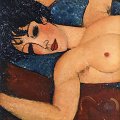 The most startling aspect of a Modigliani nude,
what makes it immediately identifiable, is the way in which the female body
is literally in your face. A more delicate way of putting it is not
possible, nor would it do justice to the manner in which the bodies
languish parallel to the picture plane and then sprawl into the foreground.
The torso rotates so that the pelvis twists up, tilts back and pushes the
hips and thighs into the viewer's proximity, disarmingly so, since the
perspective distortion makes the pubic area loom overly large by comparison
with the rest of the body.
The most startling aspect of a Modigliani nude,
what makes it immediately identifiable, is the way in which the female body
is literally in your face. A more delicate way of putting it is not
possible, nor would it do justice to the manner in which the bodies
languish parallel to the picture plane and then sprawl into the foreground.
The torso rotates so that the pelvis twists up, tilts back and pushes the
hips and thighs into the viewer's proximity, disarmingly so, since the
perspective distortion makes the pubic area loom overly large by comparison
with the rest of the body.
The models lie with their shoulders back and arms raised, their round abundant breasts echoing the undulations upward and out. The women's bodies flow expansively beyond the edge, as if to emphasise that the bounded plane of the canvas cannot adequately encompass the swell and stretch of line and muscle. Modigliani's compositional strategies draw attention to the physicality of the human form and to a female sexuality that exceeds the 'normal' confinements of the nude in painting. Although his canvases are only average size, these images often take up the entire room. Long before Helmut Newton, Amedeo Modigliani did big nudes, big in presence, sexuality and historical ambition.
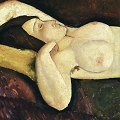 The seductive quality of Modigliani's nudes presents a
problem: are they compelling experiments in modernist form, or kitschy
images of women putting on the look of sexual desire? Are they art, or are
they soft pornography? The aesthetics of high art tease out the perceptual
capacities with the aim of transcending the material everyday. Vulgar and
demeaning by definition, soft pornography plays on our 'base' instincts.
But perhaps the two are not such strange bedfellows here. What may begin as
disinterested formal analysis or salacious curiosity turns into an
engagement of the senses and the mind, not only with the female as sex
object, but also with the pictorial embodiment of carnality, with the
unadulterated truth of the body. Modigliani unites the flesh of the model
and the pictorial surface into something sentient and alive.
The seductive quality of Modigliani's nudes presents a
problem: are they compelling experiments in modernist form, or kitschy
images of women putting on the look of sexual desire? Are they art, or are
they soft pornography? The aesthetics of high art tease out the perceptual
capacities with the aim of transcending the material everyday. Vulgar and
demeaning by definition, soft pornography plays on our 'base' instincts.
But perhaps the two are not such strange bedfellows here. What may begin as
disinterested formal analysis or salacious curiosity turns into an
engagement of the senses and the mind, not only with the female as sex
object, but also with the pictorial embodiment of carnality, with the
unadulterated truth of the body. Modigliani unites the flesh of the model
and the pictorial surface into something sentient and alive.
It is often observed that a Modigliani nude resembles a Playboy centrefold, but it is really the other way around: Modigliani initiated the compressed view and rectangular format whereby nudity unfolds before the eye. He was the first to represent a female (or any) body in this manner and, in doing so, upset the conventional relationship between the viewer and the flesh and genitalia on display. Modigliani's nudes lie in a restricted visual field that allows for minimum allusion. The broad areas of colour and shape designate the background wall, the surface of a couch, a blanket and a pillow, but their identities are almost unimportant, as the luxuriant hues serve only to accentuate the bodies' curves and highlight the glow of skin, to force the viewer into close encounters of an overly familiar kind.
Amedeo Modigliani Art
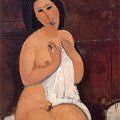
|
|
The frankness of Modigliani's bodies collapses the distinction between naked and nude, and follows from the invasive and liberating 'honesty' of the camera.
- Nude with Hat (1908)
- Caryatid (1913)
- Caryatid of 'Mademoiselle Grain de Cafe' (1912)
- Reclining Nude with Loose Hair (1917)
- Seated Nude in Shift (1917)
- Blonde Nude (1917)
- Recumbent Nude (1917)
- Red-Haired Young Woman in Shift (The Dairymaid) (1918)
- Nude with Fresco (1919)
- Landscape, Southern France (1919)
- Tree and Houses (1919)
Nude with Hat (1908)
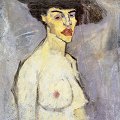 Get
Get  a high-quality picture of
Nude with Hat for your computer or notebook. ‣
The title traditionally conferred on this work, Nude with Hat, seems to be an error; the "hat" is rather a dark background for the head. The model has not been identified, but almost certainly she sat for Jewess, the first work that Modigliani exhibited at the Salon des Independants, in 1908.
a high-quality picture of
Nude with Hat for your computer or notebook. ‣
The title traditionally conferred on this work, Nude with Hat, seems to be an error; the "hat" is rather a dark background for the head. The model has not been identified, but almost certainly she sat for Jewess, the first work that Modigliani exhibited at the Salon des Independants, in 1908.
Caryatid (1913)
 Get
Get  a high-quality picture of
Caryatid for your computer or notebook. ‣
Sculpture was Modigliani's ambition, and the sculptor's art is clear in this Caryatid. It was inspired by Etruscan sculpture, but also by "Negro" and Khmer art, both all the rage when Modigliani arrived in Paris, and he took his new friend Paul Alexandre to see the ethnographic museum at the Trocadero. But the atmosphere of this painting owes less to the magic or fetishistic quality of Negro art and more to the hieratic aspect common to Archaic Greek statues and the primitive and totemic Kiss that Brancusi had made in 1908, when he and Modigliani had just been introduced by Paul Alexandre. The many Caryatids that Modigliani drew from 1910 onwards are preparatory studies for sculptures. He executed two full-length caryatids in stone; the remainder are only heads. Between 1911 and 1913, Modigliani made just under a dozen large-format oil paintings of caryatids, in-depth studies for the sculptures that he dreamed of executing: this is a fine example.
a high-quality picture of
Caryatid for your computer or notebook. ‣
Sculpture was Modigliani's ambition, and the sculptor's art is clear in this Caryatid. It was inspired by Etruscan sculpture, but also by "Negro" and Khmer art, both all the rage when Modigliani arrived in Paris, and he took his new friend Paul Alexandre to see the ethnographic museum at the Trocadero. But the atmosphere of this painting owes less to the magic or fetishistic quality of Negro art and more to the hieratic aspect common to Archaic Greek statues and the primitive and totemic Kiss that Brancusi had made in 1908, when he and Modigliani had just been introduced by Paul Alexandre. The many Caryatids that Modigliani drew from 1910 onwards are preparatory studies for sculptures. He executed two full-length caryatids in stone; the remainder are only heads. Between 1911 and 1913, Modigliani made just under a dozen large-format oil paintings of caryatids, in-depth studies for the sculptures that he dreamed of executing: this is a fine example.
Caryatid of 'Mademoiselle Grain de Cafe' (1912)
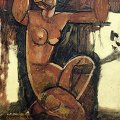 Get
Get  a high-quality picture of
Caryatid of 'Mademoiselle Grain de Cafe' for your computer or notebook. ‣
Natalia Lyanda believes that we should see in this caryatid an evocation of the great Russian poet Anna Akhmatova (1889-1966). Akhmatova arrived in Paris in May 1910. She bad just married the poet Nikolay Gumilyov, but their relationship had already soured. Akhmatova later said of Modigliani: "I was lucky, I met him before everyone else. Everyone who remembers Modigliani now made friends with him in 1914, 1915. Whereas 1 knew him in 1910 and 1911". She often modelled for Modigliani: "You see, it was not likeness that interested him. It was the pose. He made some twenty drawings of me", representing her as a dancer or Egyptian princess. Her slender, graceful body and her handsome face with its aquiline profile, short fringe and hair done up in a knot do indeed appear in many drawings and a number of sculptures. Akhmatova's turbulent life and the vicissitudes of political persecution meant that only a single Modigliani drawing survived in her possession, as testimony of an 'amitie amoureuse' that seems to have been entirely reciprocal. Behind the kneeling woman, we see the dark figure of a man, in which Lyanda perceives Maldoror, Modigliani's imaginary double.
a high-quality picture of
Caryatid of 'Mademoiselle Grain de Cafe' for your computer or notebook. ‣
Natalia Lyanda believes that we should see in this caryatid an evocation of the great Russian poet Anna Akhmatova (1889-1966). Akhmatova arrived in Paris in May 1910. She bad just married the poet Nikolay Gumilyov, but their relationship had already soured. Akhmatova later said of Modigliani: "I was lucky, I met him before everyone else. Everyone who remembers Modigliani now made friends with him in 1914, 1915. Whereas 1 knew him in 1910 and 1911". She often modelled for Modigliani: "You see, it was not likeness that interested him. It was the pose. He made some twenty drawings of me", representing her as a dancer or Egyptian princess. Her slender, graceful body and her handsome face with its aquiline profile, short fringe and hair done up in a knot do indeed appear in many drawings and a number of sculptures. Akhmatova's turbulent life and the vicissitudes of political persecution meant that only a single Modigliani drawing survived in her possession, as testimony of an 'amitie amoureuse' that seems to have been entirely reciprocal. Behind the kneeling woman, we see the dark figure of a man, in which Lyanda perceives Maldoror, Modigliani's imaginary double.
Reclining Nude with Loose Hair (1917)
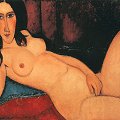 Get
Get  a high-quality picture of
Reclining Nude with Loose Hair for your computer or notebook. ‣
Lipchitz spoke of Modigliani's intense interest in people: "this explains the remarkable individuality of his portraits," he says, and "the frank sexuality of his nudes". Whether or not this superb painting was exhibited at Berthe Weill's gallery in December 1917 - four paintings were simply entitled Nude - it perfectly matches Lipchitz's observation and may well have elicited the scandal caused by the exhibition. Francis Carco is fervent in praise of Modigliani's nudes: "If you have given sustained attention to a Modigliani, when you stand in front of those cold, glistening schoolbook academies, with their inflatable bodies, spare-part breasts, and buttocks wobbling like jellies, you cannot keep a straight face. For in the warm reek of his paintings, Modigliani has set vibrating the very ecstasy of the mysteries - the shudders and the moistness- the undulations. An air comes off his nudes, which is the very breath of life". The picture quickly left Paris for Japan, having been bought from Paul Guillaume by Shigetaro Fukushima, the Japanese Ambassador to France, around 1928-29. He took the picture back with him to Japan, where it was sold to Yamamoto before being acquired by the city of Osaka. There was at one stage a rumour that this painting was merely a copy of a lost original. Though this allegation has been disproven, it has been repeated in recent times, in particular by Osvaldo Patani. The scientific evidence is clear. Comparative examination of the weave of the texture of the work has been conducted, using the very precise archive photos taken by Paul Guillaume and kept by Baron Fukushima. Pigment analyses have also been conducted, while X-ray analysis shows a significant pentimento near the cushion. The concurrence of these results is irrefutable proof that the work is an original.
a high-quality picture of
Reclining Nude with Loose Hair for your computer or notebook. ‣
Lipchitz spoke of Modigliani's intense interest in people: "this explains the remarkable individuality of his portraits," he says, and "the frank sexuality of his nudes". Whether or not this superb painting was exhibited at Berthe Weill's gallery in December 1917 - four paintings were simply entitled Nude - it perfectly matches Lipchitz's observation and may well have elicited the scandal caused by the exhibition. Francis Carco is fervent in praise of Modigliani's nudes: "If you have given sustained attention to a Modigliani, when you stand in front of those cold, glistening schoolbook academies, with their inflatable bodies, spare-part breasts, and buttocks wobbling like jellies, you cannot keep a straight face. For in the warm reek of his paintings, Modigliani has set vibrating the very ecstasy of the mysteries - the shudders and the moistness- the undulations. An air comes off his nudes, which is the very breath of life". The picture quickly left Paris for Japan, having been bought from Paul Guillaume by Shigetaro Fukushima, the Japanese Ambassador to France, around 1928-29. He took the picture back with him to Japan, where it was sold to Yamamoto before being acquired by the city of Osaka. There was at one stage a rumour that this painting was merely a copy of a lost original. Though this allegation has been disproven, it has been repeated in recent times, in particular by Osvaldo Patani. The scientific evidence is clear. Comparative examination of the weave of the texture of the work has been conducted, using the very precise archive photos taken by Paul Guillaume and kept by Baron Fukushima. Pigment analyses have also been conducted, while X-ray analysis shows a significant pentimento near the cushion. The concurrence of these results is irrefutable proof that the work is an original.
Seated Nude in Shift (1917)
 Get
Get  a high-quality picture of
Seated Nude in Shift for your computer or notebook. ‣
Modigliani's nudes have certainly been instrumental in winning and conserving the affection of the public over the last seventy years and more. It was an interest manifested early in his career; in 1902, he enrolled in the Scuola Libera di Nudo at Florence, and continued his studies the following year at the Istituto di Belle Arti in Venice, while simultaneously taking extra-curricular life classes. In Paris, he could not afford models. Only with the aid of Zborowski, from 1916 on, could he at last paint other subjects than his own circle of friends and relatives. A first and important series of nudes dates from 1917. This is surely one of the most successful; the model takes up the pose familiar from his portraits, seated full-face on a dark, neutral background. Three colours -brown, flesh-tone and white - contrive a sobre, elegant, representation. Note how the locks of hair are underlined using the tip of the stem of the brush, a technique he often used.
a high-quality picture of
Seated Nude in Shift for your computer or notebook. ‣
Modigliani's nudes have certainly been instrumental in winning and conserving the affection of the public over the last seventy years and more. It was an interest manifested early in his career; in 1902, he enrolled in the Scuola Libera di Nudo at Florence, and continued his studies the following year at the Istituto di Belle Arti in Venice, while simultaneously taking extra-curricular life classes. In Paris, he could not afford models. Only with the aid of Zborowski, from 1916 on, could he at last paint other subjects than his own circle of friends and relatives. A first and important series of nudes dates from 1917. This is surely one of the most successful; the model takes up the pose familiar from his portraits, seated full-face on a dark, neutral background. Three colours -brown, flesh-tone and white - contrive a sobre, elegant, representation. Note how the locks of hair are underlined using the tip of the stem of the brush, a technique he often used.
Blonde Nude (1917)
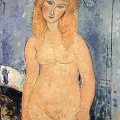 Get
Get  a high-quality picture of
Blonde Nude for your computer or notebook. ‣
"Modigliani sees only woman, tender flesh offered up and embellished with all that the higher emotions of art add to sensual desire, and Monsieur Salmon is right to say that he 'is our only painter of the nude'". Thus Francis Carco, the first owner of the painting, which he bought for seventy-five francs. It was no doubt exhibited at Berthe Weill's gallery in December 1917, contributing to the huge scandal caused by these "shameless" nudes. A zealous police superintendent even threatened to seize the paintings the very evening of the vernissage. Two years later, Francis Carco reproduced the painting in his article on Modigliani in L'Eventail. He subsequently sold it for 250,000 francs to the dealer Jos Hessel: "Only it was no longer called Nude Blonde in Shift. Jos's friends had dubbed it The Log!". Most Modigliani nudes are darker; here the model's blonde coloration lights up the painting. The dabbed - almost pointilliste - brushstrokes give the colour real vibrancy. Lunia Czechowska describes Modigliani's brush strokes in this painting as "furious"; Zborowski had interrupted the sitting, coming into the studio out of mere curiosity, and Modigliani had reacted as if to "the violation of a sanctuary". Her testimony may help to explain the tormented, vividly coloured background - quite outside Modigliani's habits - which admirably sets off the cool, milky skin-tones of the young woman.
a high-quality picture of
Blonde Nude for your computer or notebook. ‣
"Modigliani sees only woman, tender flesh offered up and embellished with all that the higher emotions of art add to sensual desire, and Monsieur Salmon is right to say that he 'is our only painter of the nude'". Thus Francis Carco, the first owner of the painting, which he bought for seventy-five francs. It was no doubt exhibited at Berthe Weill's gallery in December 1917, contributing to the huge scandal caused by these "shameless" nudes. A zealous police superintendent even threatened to seize the paintings the very evening of the vernissage. Two years later, Francis Carco reproduced the painting in his article on Modigliani in L'Eventail. He subsequently sold it for 250,000 francs to the dealer Jos Hessel: "Only it was no longer called Nude Blonde in Shift. Jos's friends had dubbed it The Log!". Most Modigliani nudes are darker; here the model's blonde coloration lights up the painting. The dabbed - almost pointilliste - brushstrokes give the colour real vibrancy. Lunia Czechowska describes Modigliani's brush strokes in this painting as "furious"; Zborowski had interrupted the sitting, coming into the studio out of mere curiosity, and Modigliani had reacted as if to "the violation of a sanctuary". Her testimony may help to explain the tormented, vividly coloured background - quite outside Modigliani's habits - which admirably sets off the cool, milky skin-tones of the young woman.
Recumbent Nude (1917)
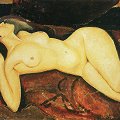 Get
Get  a high-quality picture of
Recumbent Nude for your computer or notebook. ‣
Gustave Coquiot chose this sculptural nude to illustrate a page of his 1923 book Cubistes, futuristes, passeistes; three years earlier, he had observed: "No doubt many of his nudes are too uniform in their skin-tone, that apricot shade so fashionable at the time - how many young women had their faces transformed into warm, nostalgic fruit by it; but this Far Eastern colour - ah, patina of opium! - is surely preferable to the varieties of eczematous pink so often inflicted on us". This large nude provokes the spectator not by her gaze - she seems to be asleep - but by the complete abandon of her pose, as though offered up to the eye. Like many of Modigliani's 1917 nudes, she is outlined against the dark red, scroll-patterned fabric of the sofa on which she stretches out, all innocent voluptuousness.
a high-quality picture of
Recumbent Nude for your computer or notebook. ‣
Gustave Coquiot chose this sculptural nude to illustrate a page of his 1923 book Cubistes, futuristes, passeistes; three years earlier, he had observed: "No doubt many of his nudes are too uniform in their skin-tone, that apricot shade so fashionable at the time - how many young women had their faces transformed into warm, nostalgic fruit by it; but this Far Eastern colour - ah, patina of opium! - is surely preferable to the varieties of eczematous pink so often inflicted on us". This large nude provokes the spectator not by her gaze - she seems to be asleep - but by the complete abandon of her pose, as though offered up to the eye. Like many of Modigliani's 1917 nudes, she is outlined against the dark red, scroll-patterned fabric of the sofa on which she stretches out, all innocent voluptuousness.
Red-Haired Young Woman in Shift (The Dairymaid) (1918)
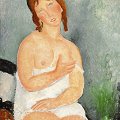 Get
Get  a high-quality picture of
Red-Haired Young Woman in Shift (The Dairymaid) for your computer or notebook. ‣
Modigliani painted a series of three or even four versions of this young dairymaid. In this and one other, the model has chestnut-brown hair. Like a modern Fornarina, she appears in a pose directly inherited from Raphael, though it is here reversed. In the others, the young woman sports the same ringlets, but is apparently blonde. Modigliani painted her seated, each time in almost identical poses, wearing a shift that leaves one breast exposed. But it is clearly the same plump young woman; she has rather broad nostrils, and the colour of her eyes harmonizes with the background of the picture.
a high-quality picture of
Red-Haired Young Woman in Shift (The Dairymaid) for your computer or notebook. ‣
Modigliani painted a series of three or even four versions of this young dairymaid. In this and one other, the model has chestnut-brown hair. Like a modern Fornarina, she appears in a pose directly inherited from Raphael, though it is here reversed. In the others, the young woman sports the same ringlets, but is apparently blonde. Modigliani painted her seated, each time in almost identical poses, wearing a shift that leaves one breast exposed. But it is clearly the same plump young woman; she has rather broad nostrils, and the colour of her eyes harmonizes with the background of the picture.
Nude with Fresco (1919)
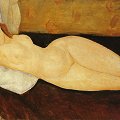 Get
Get  a high-quality picture of
Nude with Fresco for your computer or notebook. ‣
The legendary scandal caused by Modigliani's nudes at the Berthe Weill exhibition in 1917 has assured his success ever since. Two years later Modigliani painted three variations on the same theme, each identical in format, in which the model lies back on a cushion, with her head resting on her right arm. The two that feature in the present exhibition are the most finished of these. The third is painted in large strokes that leave the white ground visible in many places. In the present work, the harmonious convexities of the model are inscribed on the dark rectangle of the background. In 1917 Modigliani's models were painted staring boldly into the eyes of the spectator; here, the model's lowered gaze-she may even be asleep-create an atmosphere of gentleness and tendresse.
a high-quality picture of
Nude with Fresco for your computer or notebook. ‣
The legendary scandal caused by Modigliani's nudes at the Berthe Weill exhibition in 1917 has assured his success ever since. Two years later Modigliani painted three variations on the same theme, each identical in format, in which the model lies back on a cushion, with her head resting on her right arm. The two that feature in the present exhibition are the most finished of these. The third is painted in large strokes that leave the white ground visible in many places. In the present work, the harmonious convexities of the model are inscribed on the dark rectangle of the background. In 1917 Modigliani's models were painted staring boldly into the eyes of the spectator; here, the model's lowered gaze-she may even be asleep-create an atmosphere of gentleness and tendresse.
Landscape, Southern France (1919)
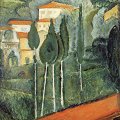 Get
Get  a high-quality picture of
Landscape, Southern France for your computer or notebook. ‣
The countryside and landscape painting seem to have held no attractions for Modigliani. Jeanne Modigliani says that her father spent one rainy week in August of 1911 in Normandy, having been dragged there by his aunt Laure for the purity of the air. This was, however, quite exceptional, and merely confirms Modigliani's reluctance to leave Paris. Yvetot and Fecamp were at the time rather monotonous little towns, bustling and hard-working, and did not, as portraiture could, lend themselves to idealizing interpretations. By contrast, having already spent several months in the south, Modigliani here gives full expression to the serenity of the landscape, replete with its childhood memories: the density of colour, the brilliant light, and the red of the Roman tiles answering the green of the middle-ground cypresses, are overt reminiscences of Tuscany. Modigliani's nostalgia for his native land was deep-rooted; he is said to have murmured "Cara Italia" on his deathbed. Cagnes and Nice, on the same latitude as his native Leghorn, share its Mediterranean light and waters.
a high-quality picture of
Landscape, Southern France for your computer or notebook. ‣
The countryside and landscape painting seem to have held no attractions for Modigliani. Jeanne Modigliani says that her father spent one rainy week in August of 1911 in Normandy, having been dragged there by his aunt Laure for the purity of the air. This was, however, quite exceptional, and merely confirms Modigliani's reluctance to leave Paris. Yvetot and Fecamp were at the time rather monotonous little towns, bustling and hard-working, and did not, as portraiture could, lend themselves to idealizing interpretations. By contrast, having already spent several months in the south, Modigliani here gives full expression to the serenity of the landscape, replete with its childhood memories: the density of colour, the brilliant light, and the red of the Roman tiles answering the green of the middle-ground cypresses, are overt reminiscences of Tuscany. Modigliani's nostalgia for his native land was deep-rooted; he is said to have murmured "Cara Italia" on his deathbed. Cagnes and Nice, on the same latitude as his native Leghorn, share its Mediterranean light and waters.
Tree and Houses (1919)
 Get
Get  a high-quality picture of
Tree and Houses for your computer or notebook. ‣
Modigliani spent over a year in the south of France, from spring 1918 to late May 1919. From March to August 1918, Paris had been bombarded by "Big Bertha", an immense artillery weapon with an unprecedented range of over a hundred kilometres. Bertha, of uncertain ballistics, killed at random, terrorizing the Parisian population. The combination of this threat and the start of the Spanish flu epidemic led many people to leave Paris. Thanks to the help of the collector Jones Netter, Zborowski and his wife, Hanka, left for the south of France with all their painter friends; these included Modigliani, Soutine and Foujita. Modigliani was accompanied by Jeanne and her mother; in November Jeanne gave birth to a daughter, also called Jeanne. In the south, the party found other denizens of Montparnasse holidaying: Foujita's wife Fernande Barrey, Cendrars, Leopold Survage, and Paul Guillaume. Modigliani and family settled first in Cagnes, then in Nice. We possess only four Modigliani landscapes, all of them of southern France. Modigliani seems to have felt no attraction for the countryside, nor for parks and gardens, nor even for the urban and roof landscapes of Paris. Faced with an abrupt change of atmosphere, inspiration, environment and light, he presumably wished to attempt a genre in which he at first showed himself somewhat clumsy. But the harmony of the blues - the sky and the distant prospect of sea - vibrate like a nostalgic echo of his Leghorn childhood on the shores of the Mediterranean.
a high-quality picture of
Tree and Houses for your computer or notebook. ‣
Modigliani spent over a year in the south of France, from spring 1918 to late May 1919. From March to August 1918, Paris had been bombarded by "Big Bertha", an immense artillery weapon with an unprecedented range of over a hundred kilometres. Bertha, of uncertain ballistics, killed at random, terrorizing the Parisian population. The combination of this threat and the start of the Spanish flu epidemic led many people to leave Paris. Thanks to the help of the collector Jones Netter, Zborowski and his wife, Hanka, left for the south of France with all their painter friends; these included Modigliani, Soutine and Foujita. Modigliani was accompanied by Jeanne and her mother; in November Jeanne gave birth to a daughter, also called Jeanne. In the south, the party found other denizens of Montparnasse holidaying: Foujita's wife Fernande Barrey, Cendrars, Leopold Survage, and Paul Guillaume. Modigliani and family settled first in Cagnes, then in Nice. We possess only four Modigliani landscapes, all of them of southern France. Modigliani seems to have felt no attraction for the countryside, nor for parks and gardens, nor even for the urban and roof landscapes of Paris. Faced with an abrupt change of atmosphere, inspiration, environment and light, he presumably wished to attempt a genre in which he at first showed himself somewhat clumsy. But the harmony of the blues - the sky and the distant prospect of sea - vibrate like a nostalgic echo of his Leghorn childhood on the shores of the Mediterranean.
Amedeo Modigliani Art

|
|
More
Articles
 Art Encyclopedia A world history of art in articles.
Art Encyclopedia A world history of art in articles.
Modernism
Amedeo Modigliani
Portraits and figure paintings.
Erotica art nudes.
Art
 Art Wallpapers Art image collections for your desktop.
Art Wallpapers Art image collections for your desktop.
Munch Art, $19
(75 pictures)
Malevich Art, $25
(105 pictures)
Modigliani Art, $29
(135 pictures)
Klee Art, $25
(150 pictures)
Miro Art, $35
(150 pictures)
Matisse Art, $29
(180 pictures)
Picasso Art, $29
(175 pictures)
Dali Art, $35
(275 pictures)
Chagall Art, $35
(175 pictures)

